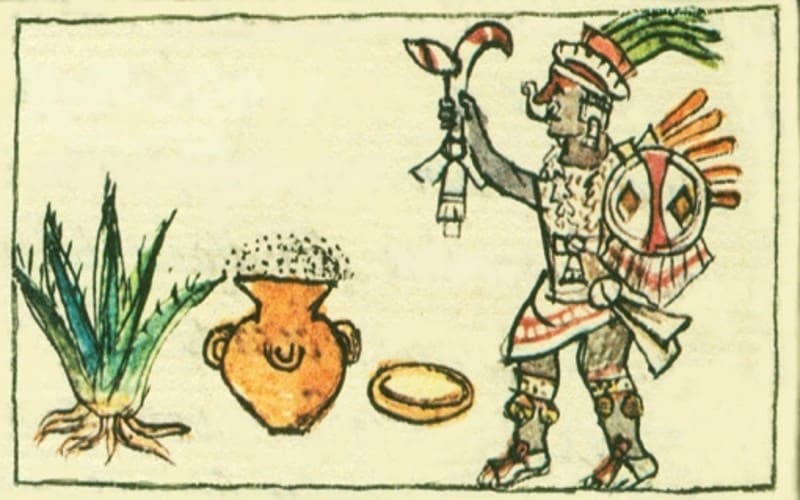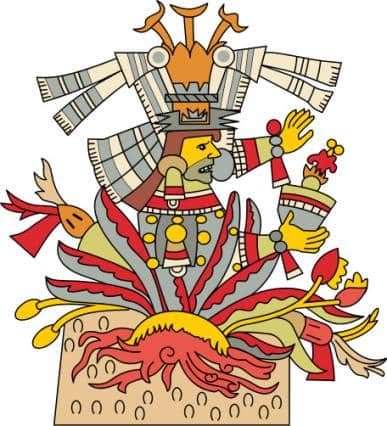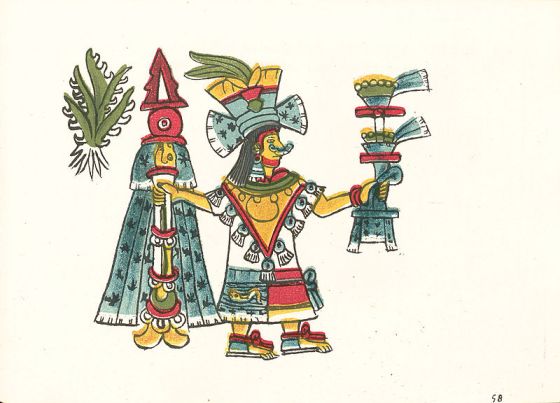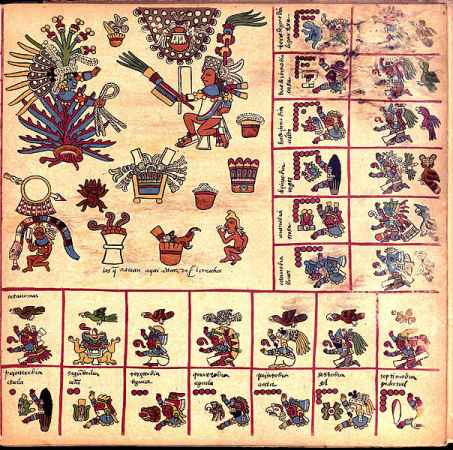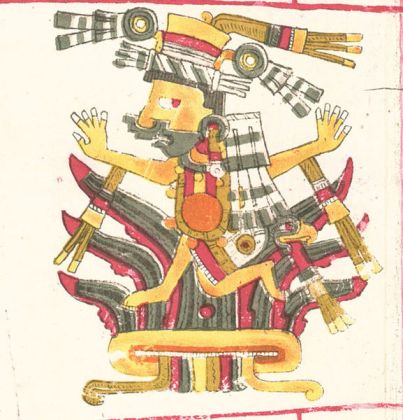Life in the Aztec societies wasn’t easy, and it was just as harsh as the landscape surrounding the Aztec settlements. To survive in such a harsh environment, flora, fauna, and humans had to be resilient and tough. Even their goddesses had to be tough, and Mayahuel certainly fits that description.
She is the Aztec goddess of the maguey plant, a flowering plant also known as Agave americana. This can sound a bit weird at first; how is a goddess ruling over one plant significant at all? The only way to find out is to keep reading!
Mayahuel’s Origin Story
As with other Aztec goddesses, Mayahuel’s origin story is filled with drama, love, murder, and betrayal. Additionally, Mayahuel’s origin story comes in several significantly different versions, which is also typical for other gods and goddesses.
First Version
Mayahuel was a young and beautiful virgin goddess. At first glance, she had everything she wanted, but that was far from the truth. In reality, she was a prisoner in her own home, longing for love, passion, freedom, and adventure.
Mayahuel had a jealous and possessive grandmother, Tzitzímitl. Tzitzímitl kept her granddaughter hidden in a secluded corner of the universe. Lonely and bored, Mayahuel spent her nights sitting on the edge of a cloud, singing her song of solitude.
One day, Ehecatl, The Serpent God of the Wind, heard Mayahuel’s song through the wind that he sent to four corners of the universe. The tune enchanted him, and he followed it until its source – Mayahuel.
As often happens, Ehecatl instantly fell in love with the beautiful goddess and her captivating song. He started caressing her body with his breeze as his passion grew stronger and stronger.
The Escape and The Vengeance
Mayahuel was also captivated by Ehecatl’s charm. Carried by his wind, she slowly danced with her lover until they became one. They did this over and over again for many nights until one night, Mayahuel left her prison forever.
Tzitzímitl was furious, but she also knew that there was no way to separate young lovers. That’s why she decided to kill them instead. Aware of her plans, Ehecatl wrapped Mayahuel in his winds and transported her to Earth, where he joined her.
Their embrace was so passionate and powerful that their bodies melted into one and became a beautiful plant. This plant had multiple spires full of water, symbolizing Mayahuel’s and Ehecatl’s ascent to the heavens.
This plant also had spikes to protect them from enraged Tzitzímitl. As you can see, this was the first Maguey, the agave plant.
However, the spikes weren’t good enough protection against Tzitzímitl, as she brought a sharp machete with her and used it to cut Maguey. Tzitzímitl couldn’t satiate her rage and desire for vengeance until she cut the plant into dozens of tiny pieces and used them to cook a broth for her demon legions.
The New Hope
Despite Tzitzímitl’s brutal display of power, all was not lost for Mayahuel and Ehecatl. In her blind rage, Tzitzímitl missed one small and beautiful Maguey’s spire, so she left it to dry out under the harsh desert sun.
However, Ehecatl took this small spire in the arms of his winds and planted it in fertile volcanic soil. Heartbroken and grieving, he shed many tears over this spire. These tears watered the spire, which grew into Maguey so beautiful and big that it amazed everyone who saw it.
With Maguey, Mayahuel also woke up, and she became a symbol of love, fertility, transformation, rebirth, and life’s victory over death.
The Second Version
The second version of Mayahuel’s story is surprisingly more realistic. In this variation of the story, Mayahuel is a woman who figured out how to extract the sap from an agave plant and use it for therapeutic purposes.
She was the wife of Patécatl, the man who discovered peyote. Their knowledge was so valued in their time that Aztec people gave them the status of a god and goddess. They also had sons, known as Centzontotochtin (400 rabbits), and these sons were minor deities representing different stages of drunkenness.
In another variation of this story, Patécatl was the god of healing and fertility, and Mayahuel was the goddess of the Maguey plant. Their story is basically the same in this variation; they had similar therapeutical knowledge, and they were parents of Centzontotochtin.
The only difference between the two variations of this story is that in the first variation, Mayahuel and her husband were mortals that became gods. In the second version, they were always gods.
Mayahuel’s Role In Aztec Religion
Now that we have gone over Mayahuel’s origin story, her significance for the Aztec people is much clearer. Aztec people highly revered agave plants and they had many uses for them. Mayahuel wasn’t only the protector of these plants; she was one with them.
The Significance of Mayahuel and Maguey for Aztecs
Aztecs used Maguey, or the agave plant, for many different purposes:
- Food source: Aguamiel, agave’s sap, was a valuable food source for many Aztecs. Aztecs ate aguamiel in its fresh state or fermented it and made a drink called pulque. They also roasted the insides of this plant and used its leaves as wrapping for other foods.
- Medicine: Aztecs also used agave sap for its healing properties. This sap helped with constipation, respiratory issues, and various skin irritations.
- Religious rituals: Aztecs had many rituals to appease their goods, and in some of these rituals, they used agave plants and their saps as offerings.
- Clothing and construction: Finally, agave leaves are rich in fibers, and Aztecs used those fibers to make clothes. Aztecs also used these fibers in the construction of their homes, particularly for the roofs, walls, and flooring.
Since Mayahuel and Maguey were the same for the Aztecs, they believed that this goddess provided them with food, clothes, shelter, and medicine. As such, Aztecs considered her a part of the group of Aztec goddesses associated with motherhood and fertility.
The Emotional and Spiritual Symbolism of Mayahuel’s Story

Mayahuel remains relevant even today. Her spiritual and emotional significance goes beyond her cultural and religious significance. Mayahuel’s story is full of powerful symbols that can guide us toward happier lives. We just need to know where to look:
Resilience
Everyone who is at least slightly familiar with gardening and agave plants knows how resilient they are. They thrive in places where everything else would fail, as they are fully adapted to the hot and dry climate of Mexico and its deserts.
This hardiness is a valuable lesson for us all. The agave plant and Mayhuel, by association, show us the power of being able to adapt to even the harshest conditions. It is easy to thrive when the conditions are optimal, but they rarely are.
We all go through different life phases, with some of these phases being full of opportunities and good things for us, making us feel like we found ourselves in a lush oasis. Then, we enter the life stage in which we feel like we ended up in a desert; every moment is harsh, and our daily life feels so barren.
In such periods, we need to be like Maguey. Just like this plant is able to preserve its juices and survive long periods without rain, we need to preserve our energy, hope, and strength that will guide us through the hard times.
Self-Defense
The Maguey plant leaves have also partially developed into spikes, which is a defense mechanism by various “predators.” This is another important lesson: we need to be able to defend ourselves in case someone tries to intrude on our world.
This doesn’t mean that we need to scare away everyone who approaches us or tries to get closer to us in an emotional way. It only means that we need to be able to set our boundaries and enforce them when in situations that require it.
Rebirth
Mayahuel was brutalized by her grandmother, and for a moment, it seemed like she was forever gone. However, thanks to Ehecatl, she was able to awake stronger and more beautiful than ever.
Maybe the people around you are pushing you down and hurting you intentionally. Maybe life has dealt you blows that you don’t think you can recover from. If any of this is true and you feel like you have reached your lowest point, remember Mayahuel.
If she came back from the dead, so can you. She had Ehecatl, and you need to find your Ehecatl. That doesn’t even have to be a person. Your Ehecatl can be anything that motivates you to keep fighting.
Healing
So many people live their lives carrying their unhealed traumas and heartbreaks. Because of this, there is so much pain and suffering in this world. Those unhealed people then cause new wounds to themselves and to other people, sometimes on accident, sometimes unintentionally.
Mayahuel is there to help heal our wounds; we just need to recognize that we need healing. The process of healing is never easy, especially if the wounds are deep. However, it is important that we heal these wounds for the sake of a happier and healthier future.
Power of Love
Love is certainly a driving force for many people, and this is true for all types of love, not only for romantic love. There are countless examples of heroic and other impressive feats that people achieve out of love for their family, friends, communities, and even countries.
Ehecatl’s love brought Mayahuel back to life and annulled all of the efforts of Tzitzímitl. Having someone to love you and loving them back can also help you neutralize many bad things in your life.
Surround yourself with your loved ones. It doesn’t matter if it’s your family, friend group, or your partner. Having people that love you and deeply care for you is such a privilege that not everyone has, so keep them close!
Mayahuel’s Relationship to Other Goddesses
The most significant Mayahuel’s relationship with another goddess is certainly the one with her grandmother Tzitzímitl. Her grandmother was portrayed as being jealous and possessive of Mayahuel, but we never see the reasons for such behavior.
Of course, there isn’t a reason that could justify Tzitzímitl’s abuse and violence towards Mayahuel. Tzitzímitl’s motive could only give us more perspective on why she turned out to be so cruel.
In all Aztec myths that mention Tzitzímitl, she is an antagonist and a monstrous figure. But who knows, maybe she was badly hurt in the past. Maybe her possessiveness and jealousy were her way of protecting her granddaughter from the same fate.
Of course, this is only a rambling, with no sources that point to this theory being true. However, it would be somewhat poetic and even more tragic if Tzitzímitl wasn’t just evil and if her backstory was more sympathetic.
Other goddesses
Mayahuel is also closely related to Coatlicue, the goddess of fertility, and Tlazoteotl, the goddess of vice. For many Aztecs, these three goddesses were actually three different aspects of one mother goddess, Tonantzin.
Mayahuel also has a strong connection with other fertility goddesses, such as Coyolxauhqui, Xōchiquetzal, Chalchiuhtlicue, and many more.
Mayahuel’s Appearance and Depiction
Like many other Aztec goddesses, Mayahuel was beautiful. In the descriptions that mention her beauty, physical beauty is often a manifestation of inner beauty.
Apart from describing her as beautiful, Aztecs depicted Mayahuel sitting on top of the maguey plant, being partially fused with the plant’s leaves. In some depictions, Mayahuel had multiple breasts that were actually the leaves of the maguey plant.
One depiction of Mayahuel is particularly notable, and it is in the Codex Borbonicus. Codex Borbonicus is a manuscript written by the Aztec priests, sometimes around the Spanish Conquest, give or take several years. This manuscript contains depictions of various Aztec deities, including Mayahuel.
In Codex Borbonicus, Mayahuel wears blue clothes because the blue color was the symbol of fertility for Aztecs. She also wears a headdress made of spindles and unspun agave fibers.
Mayahuel And Her Christian Renditions
Since Mayahuel is often a part of the goddess trinity that makes the mother goddess, she is somewhat syncretized with Virgin Mary. In particular, Mayahuel is syncretized with the Virgin of Guadalupe.
Mayahuel-Like Goddesses From All Around The World
Since Mayahuel is primarily the goddess of agave plants, she has no counterparts in other cultures. However, since she is also one of the Aztec fertility goddesses, you can find her counterparts in fertility goddesses from other religions.
Practically every culture that practiced polytheism had its goddess of fertility, and some cultures even had more fertility goddesses. With that in mind, the most similar goddesses to Mayahuel are certainly Ishtar, Inanna, Isis, Hathor, Freya, Demeter, and many others.
Legacy
Mayahuel’s legacy is certainly stronger than ever after centuries of being pushed aside. Agave plants continue to be a valuable resource for Mexican people, especially those that live in rural areas.
But apart from that, Mayahuel is the goddess that teaches us how to be resilient and heals, protects, and nurtures us. Her story of rebirth and transformation shows us that it is possible to come back stronger after people defeat, hurt, and try to destroy you.
By inviting this goddess into your life, you will become like her, ready to fight for your loved ones and ready to face any challenges that life presents you with.
Symbols
For every goddess, there are certain things that are associated with her and hence become her symbols. These things can be more general, while others are more specific.
When it comes to Mayahuel, her symbols are quite obvious, but let’s go over some of the most significant ones and the meanings behind them:
General
The spindle is a common symbol of Mayahuel, and she often wears several spindles as her headdress. Apart from being used to make the rope out of agave fibers, the spindle has a deep symbolism. It symbolizes making order from the chaos.
Another interesting symbol of Mayahuel is agave sap and all its byproducts. Finally, volcanoes and their surrounding soils are also symbols of Mayahuel because one such soil was partially responsible for her rebirth. Also, volcanic soils are known to be extremely fertile.
Animals
Mayahuel is the goddess of fertility, often described as having 400 sons and 400 breasts to feed them. Her sons are also called 400 rabbits, which is why the rabbit is a good choice for the animal symbol of Mayahuel.
Apart from rabbits, there are other animals that symbolize fertility and can also be symbols of Mayahuel. These animals are cows, bees, frogs, birds, etc.
Plants
This one is pretty obvious, as Mayahuel is practically the one with agave plants. Mayahuel is described as being the first agave plant ever or as being extremely knowledgeable about this plant.
Alternatively, Mayahuel’s symbol could be a small, spineless Lophophora cactus. This cactus is a source of peyote, a psychedelic substance that was, according to one legend, discovered by Mayahuel’s husband, Patécatl.
Perfumes/Scents
The best perfume and scent notes to symbolize Mayahuel are certainly those that are reminiscent of agave plants. Agaves don’t have a particularly strong scent, not even their flowers.
However, agave’s subtle scent can be described as fresh, earthy, slightly sweet, and most similar to green leaves, green melons, aloe, and woodsy musk. With that in mind, these scent notes are the best choices for Mayhuel’s symbols.
Gems and Metals
Probably the best gem symbol of Mayahuel is the emerald, as it has a similar shade to agave plants. Other green gemstones, such as jade, agate, fluorite, malachite, etc.
Alternatively, since the blue color symbolizes Mayahuel as the color of fertility, blue gemstones such as sapphire, blue opal, turquoise, and tourmaline are also great choices to represent this goddess.
Goddess Jewelry
There are many reasons why you might want to keep a healing crystal or stone close to you. Getting closer to your goddess by wearing her color or crystal is a great one. That they also look great as jewelry only makes it so much better!
Here is a guide to crystal jewelry you hopefully will find helpful. In it is a list of 30+ crystals and links to some really great looking jewelry with that crystal or stone. Enjoy!
Colors
As I already said, Aztecs often depicted Mayahuel as wearing a blue dress. The blue color of the dress symbolizes fertility, and this color can also symbolize Mayahuel. Green is another color suitable for representing Mayahuel as a symbol of green agave plants.
Meditations
- Oh, powerful Mayahuel, help me sprout into a wiser, stronger, and better version of myself.
- Help me achieve a life of abundance, Mayahuel.
- Let your energy transform me and make me more beautiful.
- Mayahuel, help me rise up every time life brings me down.
- Teach me how to protect myself against those that want to harm me.
- Just like Mayahuel, I will survive periods of drought and patiently wait for periods of abundance.
- I honor your sacred presence and invite your energy of abundance into my life.
- Help me heal my wounds, mightly Mayahuel, make me even stronger than before.
Want To Bring More Mayahuel Qualities Into Your Life?
- Take good care of your health, both physical and mental. Take some time to heal your wounds and hurts, regardless of if they are on your body or on your soul.
- Be prepared for the bad days. Just like agave leaves store water in order to survive periods without rain, you should also prepare for periods of drought in your life. Primarily, save money as much as you can, as you can never know what the future holds.
- Take self-defense classes. While you can’t grow spikes like Mayahuel did when transforming into an agave, you can still increase your defense against people that would try to hurt you. Alternatively, you can buy pepper spray (if it is legal in your state) and carry it in your purse.
- Get yourself an agave plant. They are fairly easy to take care of, and you will feel more connected to Mayahuel by watching your plant grow. You can even try and use agave sap in various recipes, but only if you are certain that your agave is edible.
- If you still haven’t chosen your career path, or you want to change careers, consider getting a career in the medicinal field or in agriculture. Helping treat other people’s illnesses or feeding those people will bring you closer to Mayahuel.
- Alternatively, if you are interested in fashion, you can start sewing, knitting, and/or crocheting your own clothes. Since Mayahuel was often associated with agave fibres, fabrics, and spindles, this could be another way to bring some of her qualities into your life.
Featured Image Credit: Via Wikimedia Commons

